NASA Deploys Sail of Experimental Spacecraft Propelled Purely by Light
 Artist’s concept of NASA’s Advanced Composite Solar Sail System. (NASA/Aero Animation/Ben Schweighart)
Artist’s concept of NASA’s Advanced Composite Solar Sail System. (NASA/Aero Animation/Ben Schweighart)Those of you following the Advanced Composite Solar Sail System may have heard that its booms and sail are now deployed. It is receiving light pressure from the Sun to propel it through the Solar System.
Like a test pilot in a new aircraft, NASA are now testing out just how it handles. Before deployment, the spacecraft was slowly tumbling and now the controllers will see if they can get it under control and under sail power.
The reflectivity of the sail means it's an easy spot in the night sky, just fire up the NASA app to find out where to look.
Shining, shimmering, tumbling
— NASA Ames (@NASAAmes) September 5, 2024
Our Solar Sail is currently orbiting Earth, slowly tumbling as expected while the team characterizes its boom and sails. You can #SpotTheSail intermittently as it passes overhead using our tool in the #NASA_App. Learn more: https://t.co/7jXKqa19Hl pic.twitter.com/XfVetMBNMW
Solar sails are an ingenious propulsion technique that employ pressure from sunlight to generate low levels of thrust. As the photons of light strike the surface, they transfer momentum to the solar sail and therefore the spacecraft is accelerated.
The thrust is small but when applied over long periods of time can provide a very efficient way to propel small spacecraft. The first successful deployment of a sail occurred in 2010 with the IKAROS (Interplanetary Kite-craft Accelerated by Radiation of the Sun) spacecraft launched by the Japanese space agency JAXA.
The Advanced Composite Solar Sail System (ACSSS) was developed by NASA to test the technology. The boom that supports the sail is made of lighter and more durable composite materials.
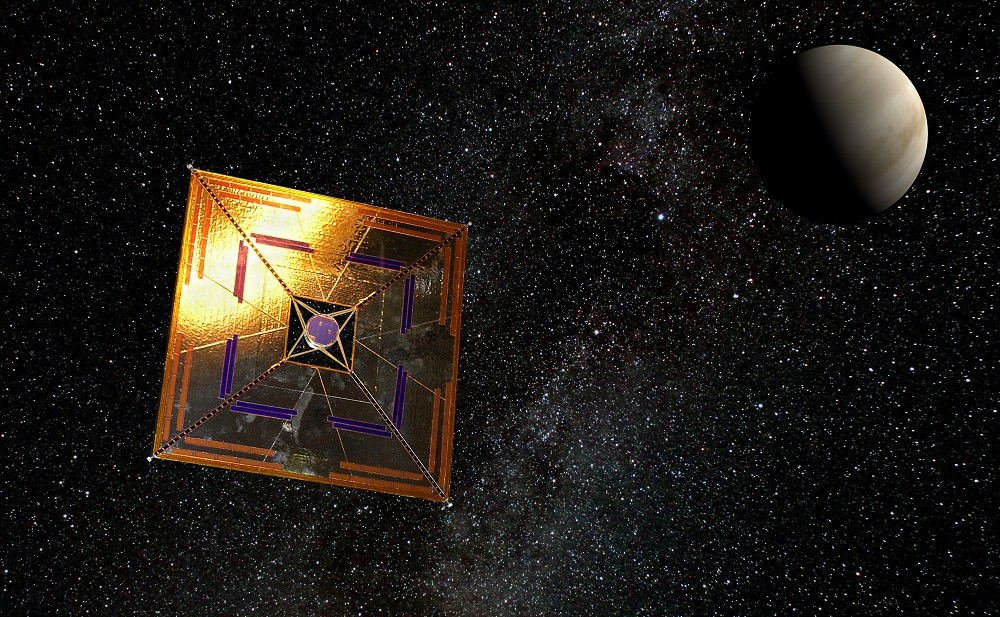
By testing the deployment of the booms and efficient sail operation, NASA hopes to prove the viability of the technology.
The ACSSS uses lighter, more flexible materials than previous attempts and will enable more efficient deep space exploration, asteroid rendezvous, and other missions requiring low-thrust propulsion. ACSSS orbits the Earth in a low orbit with an altitude of between 500-600 kilometers.
Following launch, it was released purposely without attitude control and was as a result tumbling through space. Once the analysis has been completed, and the boom and sail deployment has been understood, the team will re-engage the attitude control to stabilize the spacecraft.
The next phase then begins as the team analyze flight handling and dynamics to adjust the spacecraft's orbit.
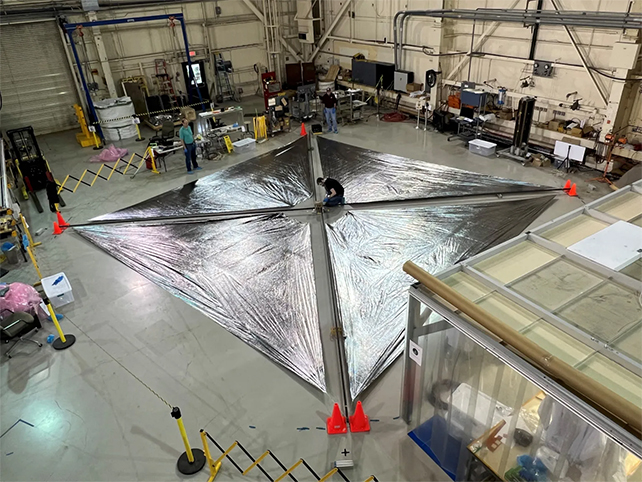
Since the deployment of the sail, the operations team continue to receive images and data to help them understand how the boom technology has deployed.
So far so good it seems for demonstrating the deployment and initial operations.
The team will continue to monitor and analyze the incoming data and images in preparation for further technology tests and demonstrations in the week ahead.
Any keen-eyed sky watchers may be able to spot the spacecraft as it passes overhead. The high reflectivity of the sail will make it clearly visible to the unaided eye.
NASA have added a new feature to their app so that users can set up notifications to get alerts when it is visible from their location. NASA is inviting the public to share their pictures of the spacecraft online using the hashtag #SpotTheSail.
NASA's solar sailing spacecraft is tumbling –
but that's part of the plan
Who needs fuel – or even engines – when you could use the sun to push a spacecraft along?
Fri 6 Sep 2024
NASA has announced its experimental ACS3 solar-sailing spacecraft is working as expected, after it was spotted tumbling in the night sky.
The 80 m2 (860 sq ft) Advanced Composite Solar Sail System (ACS3) successfully spread its sails last week. The spacecraft uses pressure produced by solar radiation to move – doing away with conventional rocket propellant. NASA is testing the sail in the hope that its design, and the materials used, are viable for future vessels.
As the boffins put it:
NASA's Advanced Composite Solar Sail System, or ACS3, technology demonstration uses composite materials – or a combination of materials with different properties – in its novel, lightweight booms that deploy from a CubeSat. Data obtained from ACS3 will guide the design of future larger-scale composite solar sail systems that could be used for space weather early warning satellites, near-Earth asteroid reconnaissance missions, or communications relays for crewed exploration missions.
Questions were raised this week after the instrument – which launched in April and is now in Earth's orbit – was observed to be slowly tumbling, gyrating, or wobbling.
NASA's Langley Research Center assured the public that's neither unusual nor worrying.
"Our Solar Sail System is sailing around Earth, slowly tumbling as expected while the mission team characterizes its boom and sails," the agency explained Thursday.
You can, we're told, track the craft from NASA's app.

Engineers at NASA's Langley Research Center work on an unfurled Advanced Composite Solar Sail System's solar sail – Click to enlarge. Source: NASA
The first probe to use solar radiation pressure as a major means for orientation during flight was NASA's 1970s-era Mariner 10, which caught sunlight on its solar panels and high-gain antenna. ACS3 is using vastly larger composite sails to do this – and hopefully far more efficiently.Bill Nye's bonkers LightSail spaceship unfurls solar sails at last
I've seen things you people wouldn't believe. Spacecraft with graphene sails powered by starlight and lasers
NASA is not alone in pursuing solar sails. Japan's JAXA managed a Venus flyby in 2010 using solar sails. And the Planetary Society executed an unfurling in 2019.
It's not ACS3's sails that are of most interest: the booms on which they hang are said to be "made from a polymer material that is flexible and reinforced with carbon fiber."
"This composite material can be rolled for compact stowage, but remains strong and lightweight when unrolled. It is also very stiff and resistant to bending and warping due to changes in temperature," according to NASA.
"The ACS3 technology demonstration will also test an innovative tape-spool boom extraction system designed to minimize jamming of the coiled booms during deployment."
Coiled components matter, because they mean items with large surface area can be packed into the small volume of spacecraft, making them easier to launch. ®
Hints of a Hidden Structure Detected at The Edge of The Solar System
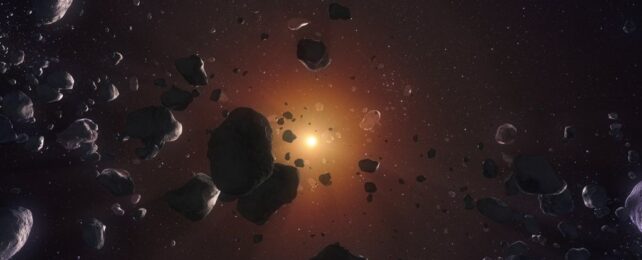 An artist's impression of the Kuiper Belt. (ESO/M. Kornmesser)
An artist's impression of the Kuiper Belt. (ESO/M. Kornmesser)If you travel far enough away from the Sun, the Solar System becomes a lot more populated.
Out past the orbit of Neptune lies the Kuiper Belt, a vast, ring-shaped field of icy rocks. This is where Pluto resides, and Arrokoth, and countless other small objects in the cold and the dark.
These are known as Kuiper Belt objects or KBOs, and astronomers have just found hints of an unexpected rise in their density, between 70 and 90 astronomical units from the Sun, separated by a large, practically empty gap between it and an inner population of KBOs closer to the Sun.
It seems, almost, like there are two Kuiper Belts, or at least two components – something nobody was expecting to find.
"If this is confirmed, it would be a major discovery," says planetary scientist Fumi Yoshida of the University of Occupational and Environmental Health Sciences and Chiba Institute of Technology in Japan.
"The primordial solar nebula was much larger than previously thought, and this may have implications for studying the planet formation process in our Solar System."
The objects in the Kuiper Belt are thought to represent the most pristine material our Solar System contains.
The belt itself extends from the orbit of Neptune, around 30 astronomical units from the Sun (an astronomical unit is the average distance between Earth and the Sun), out to about 50 astronomical units from the Sun.
This distance from the Sun means that anything within the Kuiper Belt is only minimally affected by solar radiation, which, in turn, means that KBOs likely remain pretty much unchanged since the Solar System was born, some 4.6 billion years ago.
These objects are ancient remnants of the cloud of material, known as the solar nebula, from which the Sun and planets formed.
The New Horizons spacecraft has been heading out deeper into the Solar System since its flyby of Pluto in 2015; at time of writing, the spacecraft is nearly 60 astronomical units from the Sun and counting.
To support its ongoing exploration of the outer Solar System, astronomers here on Earth have been conducting observations of the Kuiper Belt using the National Astronomical Observatory of Japan's Subaru Telescope in Hawai'i.
To date, the Subaru observations have revealed 263 new KBOs, but a large, international team of astronomers led by Wesley Fraser of the National Research Council of Canada has found that 11 of those objects are much, much farther than we thought the Kuiper Belt ended – out in the region past 70 astronomical units.
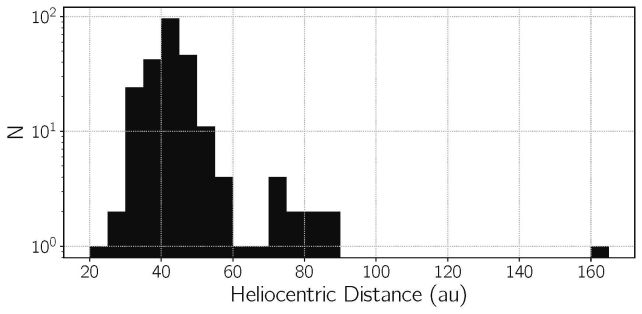
From the number of these objects spotted, the researchers were able to extrapolate the density of the outer Kuiper Belt ring. It would be lower than the inner population, but high enough to constitute a new structure.
In the region between 55 and 70 astronomical units, however, next to nothing has been found. This might sound strange, but a gap of this kind is a feature we've seen in other forming planetary systems, and it brings the Solar System more in line with what we've found elsewhere in the galaxy.
"Our Solar System's Kuiper Belt long appeared to be very small in comparison with many other planetary systems, but our results suggest that idea might just have arisen due to an observational bias," Fraser explains.
"So maybe, if this result is confirmed, our Kuiper Belt isn't all that small and unusual after all compared to those around other stars."
A lot of our observations of the Milky Way galaxy suggest that our Solar System is unusual in many ways. Since the Solar System is the only known planetary system to host life, these oddities could be contributing factors to the Solar System's habitability.
But our technology for observing space has limitations that could result in significant observation biases, suggesting peculiarities that don't actually exist. If the new observations of the Kuiper Belt are confirmed, we have just ruled out one of those peculiarities – an unusually small solar nebula.In order to shed more light on the discovery, observations continue in order to track the orbits of the 11 distant objects.
"This is a groundbreaking discovery revealing something unexpected, new, and exciting in the distant reaches of the Solar System," says New Horizons Principal Investigator Alan Stern of the Southwest Research Institute.
"This discovery probably would not have been possible without the world class capabilities of Subaru observatory."
The research has been accepted into The Planetary Science Journal and is available on arXiv.
‘Found bolide’: NASA astronaut Matthew Dominick captures ‘shooting star’ over Egypt’s Cairo | Watch video
NASA astronaut Matthew Dominick shared a timelapse capturing a bright green meteor explosion over Cairo. The video, featuring 20 images, showcases the meteor's disintegration as it entered Earth's atmosphere.

NASA astronaut Matthew Dominick is in the spotlight again for his latest video that captures a bright green meteor explosion in the night sky over Earth. The commander of the SpaceX Crew-8 mission onboard the International Space Station (ISS) shared a new series of timelapse photos.
The camera positioned over Egypt's Cairo vividly captured a bright green outburst on Monday, September 3, at 5:42 am (IST). This happened while the astronaut was trying to take a shot of the Milky Way's core. The fireball explosion shown in the timelapse resulted from the disintegration of the meteor after entering Earth's atmosphere.
Taking to social media platform X, Matthew Dominick wrote, “I showed this to a couple of friends yesterday to see what they thought.” He added, “They both thought it was a meteor exploding in the atmosphere — a rather bright one called a bolide.”
Keeping in mind the curiosity and admiration of cosmic enthusiasts and sky gazers for the miracles of the universe, Matthew Dominick shared a slowed-down timelapse to one frame per second. This enables us to see the meteor streaking and then exploding. Captured from inside the space station's Cupola module, the clip includes 20 individual images. Matthew Dominick said, “When I went to review the shots afterwards, I found the bolide.”
The astronaut shared another version of the timelapse in the comments section of the post, a longer and faster frame with the caption, “It is interesting to compare the size of the bolide blast to other objects in view like the Mediterranean, Cairo, or lightning strikes.”
In the faster version, the shooting star appears as just a brief flash at the top right of the frame.
Matthew Dominick has emerged as a prolific space photographer with magnificent shots of the aurora, moon, lightning, nebula, and more. This viral post has garnered over 32.01 lakh views in just a few days and over 21,000 likes.
NASA shares mesmerising image of Galaxy NGC 5033; netizens call it ‘sensational’
- NASA released a stunning image of Galaxy NGC 5033.

The National Aeronautics and Space Administration's (NASA) Hubble Space Telescope has captured remarkable view of NGC 5033, a spiral galaxy that shines brightly thanks to its active galactic nucleus.
The Hubble Space Telescope which launched in 1990 changed the fundamental understanding of the universe right from determining the atmospheric composition of planets around other stars to discovering dark energy.
Coming back to the image shared by Hubble, NGC 5033, which is located approximately 40 million light-years away in the Canes Venatici constellation, shares notable features with the Milky Way, NASA states. It added that both galaxies stretch roughly 100,000 light-years across and display spiral arms filled with blue regions, marking areas of active star formation.
Due to its relative proximity to Earth, NGC 5033 provides astronomers with an excellent opportunity to study the intricate details of its glowing nucleus and further understand the behavior of galaxies with active cores, the US space agency stated.
In the image shared by NASA Hubble, it shows the close-up shot of a spiral galaxy which is surrounded by spiral arms filled with dark dust and vibrant blue star-forming regions.
Netizens too were captivated by the image shared by NASA's Hubble. One person described it as "Sensational," while another enthusiastically commented, "Smash." Another user labeled it "Fancy," with one more calling it "madness." "I'm in love," expressed a different user, reflecting the widespread admiration for the stunning image.
Meanwhile, Boeing's Starliner is scheduled to undock from the International Space Station (ISS) and return without its crew members – NASA astronauts Sunita Williams and Butch Wilmore – on FrBLO
iday, September 6. NASA said in a statement on August 30 that Starliner is scheduled to "autonomously undock" from the space station at around 6:04 pm EDT Friday (or IST 3:30 am Saturday) "to begin the journey home, weather conditions permitting".
The Andromeda Galaxy, positioned 2.5 million light-years away, stands as the closest spiral galaxy to our Milky Way. Boasting over a trillion stars, it significantly contributes to galactic evolution studies. Various NASA missions have captured intricate images of Andromeda's structure and star-forming regions, enhancing our understanding of this cosmic giant.
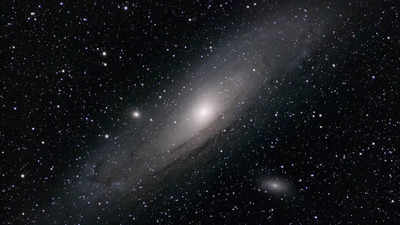
The Andromeda Galaxy (M31) is the closest spiral galaxy to the Milky Way, located about 2.5 million light-years away. It's the largest galaxy in the Local Group, containing over a trillion stars, and is visible to the naked eye from Earth under dark skies.
Andromeda is on a collision course with the Milky Way, predicted to merge in about 4.5 billion years, forming a new galaxy.
This galaxy is similar in structure to the Milky Way, with a central bulge, spiral arms, and a vast halo of stars. Andromeda plays a key role in studies of galactic evolution and dynamics.
The Andromeda Galaxy: A neighbouring giant
The Andromeda Galaxy (M31), located 2.5 million light-years away, is the closest spiral galaxy to the Milky Way. With over a trillion stars, it's the largest in the Local Group and visible to the naked eye. This galaxy plays a significant role in studies of galactic evolution and dynamics. NASA's various space missions have captured stunning images offering glimpses into the vastness of the universe, including the intricate structure of the Andromeda Galaxy.
Fascinating images captured by different NASA galaxy explorers
NASA Galaxy Evolution Explorer captures Andromeda's majesty
This image from NASA’s Galaxy Evolution Explorer highlights Messier 31 (Andromeda), the largest galaxy in the Milky Way's vicinity, revealing intricate cosmic details.
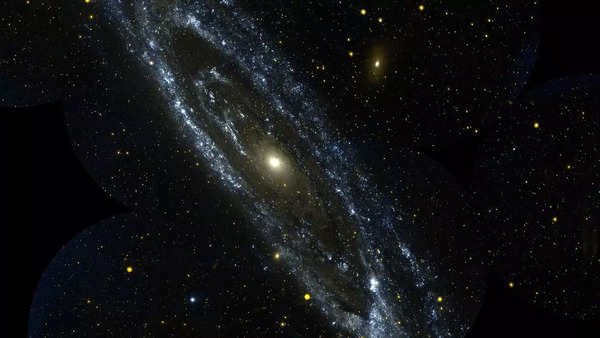
Image source: NASA
ESA Herschel mission unveils Andromeda's depths
Data from the ESA Herschel mission presents new perspectives on the Andromeda Galaxy, showcasing its expansive star-forming regions and dust clouds.

Image source: NASA
Palomar observatory's Andromeda galaxy view
Taken by the Palomar Observatory, operated by Caltech, this image of the Andromeda Galaxy captures its stunning spiral structure and the rich star field surrounding it.
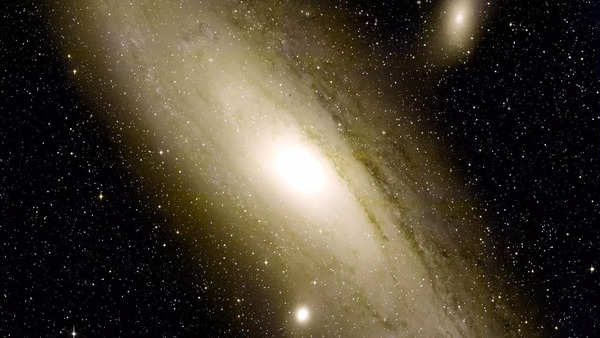
Image source: Palomar Transient Factory
NASA Wide-field Survey Explorer shows Andromeda's full glory
NASA’s Wide-field Survey Explorer captures a detailed image of the Andromeda Galaxy, offering a complete view of our galactic neighbour 2.5 million light-years away.
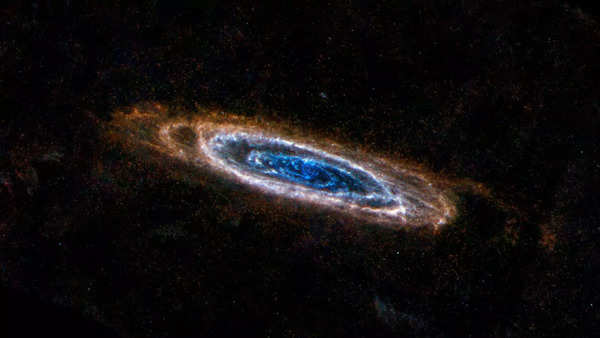
Image source: Messier Objects
NASA’s Spitzer Telescope reveals Andromeda’s hidden details
This image from NASA’s retired Spitzer Space Telescope showcases stars and dust clouds in Andromeda, highlighting star-forming regions using infrared data from the WISE mission.
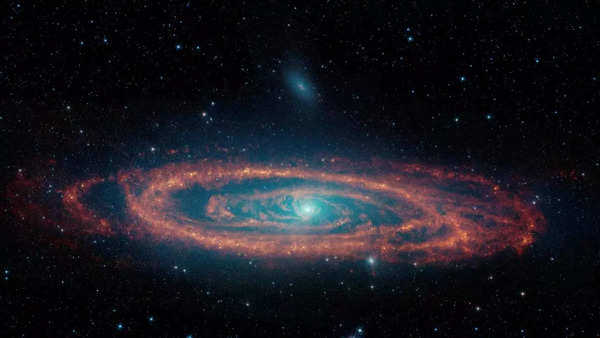
Image source: NASA
Exploring Andromeda with NASA’s Galaxy Evolution explorer
NASA's Galaxy Evolution Explorer presents a detailed image of the Andromeda Galaxy, capturing its vast spiral arms and a glimpse into its star formation activities.
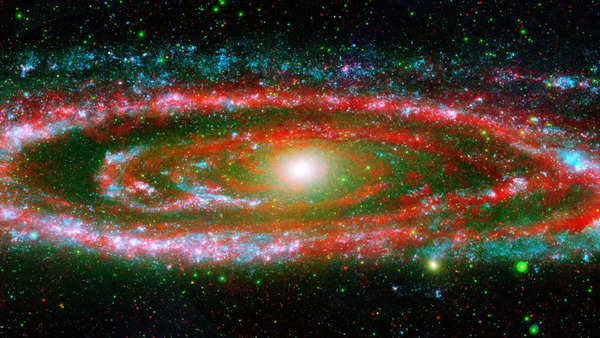
Image source: NASA
Samantha Mathewson
Thu, September 5, 2024

The Andromeda Galaxy is located about 2.5 million light-years away, making it the Milky Way's closest galactic neighbor. . | Credit: NASA, ESA, M. Boyer (Space Telescope Science Institute), and J. Dalcanton (University of Washington); Image Processing: Gladys Kober (NASA/Catholic University of America)
The rosy red structures of a nearby galaxy glow brightly in a new image from the Hubble Space Telescope.
The Andromeda Galaxy — the Milky Way's closest galactic neighbor — is located about 2.5 million light-years away. Measuring approximately 152,000 light-years across, it has nearly the same mass as our Milky Way galaxy. A recent hubble image, released on Aug. 30, captures a detailed view of the northeast region of the famed galaxy, including its intricately woven spiral arms and swathes of ionized gas that fuel star formation.
Related: Stunning Photos of Our Milky Way Galaxy (Gallery)
"The combination of stellar nurseries and supernovas create a dynamic environment that excites the surrounding hydrogen gas, flourishing it into a garden of star-studded roses," NASA officials said in a statement.
Using Hubble's Advanced Camera for Surveys and Wide Field Camera 3, researchers were able to peer through the clouds of gas and hone in on Andromeda's spiral arms to analyze the galaxy's vast collection of stars.
"The extent of the study spanned a vast range of stars, providing not just a clear view of Andromeda's stellar history and diversity, but also more insight on stellar formation and evolution overall," NASA officials said in the statement.
"By examining these stars in our local cosmic neighborhood, scientists can better understand those within galaxies in the distant universe."
Andromeda is believed to be falling toward the Milky Way due to gravitational forces between the two galaxies and the invisible dark matter that surrounds them both. Ultimately, the two galaxies are expected to experience a head-on collision in about 2 billion to 4 billion years, which will drastically alter the structure of both Andromeda and the Milky Way as we know them today. However, some new research casts doubt on this collision theory — so, perhaps only time will tell.
One of the universe's biggest paradoxes could be even weirder than we thought, James Webb telescope study reveals
Ben Turner
Thu, September 5, 2024

Credit: NASA/CXC/JPL-Caltech/STScI/NSF/NRAO/VLA
New measurements taken with the James Webb Space Telescope (JWST) have deepened the scientific controversy of the Hubble tension — suggesting it may not exist at all.
For years, astronomers have found that the universe appears to be expanding at different speeds depending on where they look, a conundrum they call the Hubble tension. Some of the measurements agree with our best current understanding of the universe, while others threaten to break it.
When JWST came online in 2022, one team of researchers used the space telescope's unprecedented accuracy to confirm the tension exists. But according to the new results from a different team of scientists, the Hubble tension may arise from measurement error and be an illusion after all. Yet even these results are not definitive.
"Our results are consistent with the standard model. But they don't rule out that there's a tension there too," study lead author Wendy Freedman, an astrophysicist at the University of Chicago, told Live Science. "[The experience] is probably the closest thing to a rollercoaster — it's been exciting, but there are these moments when you've got to climb the hill again."
Hubble trouble
Currently, there are two gold-standard methods for figuring out the Hubble constant, a value that describes the expansion rate of the universe. The first involves poring over tiny fluctuations in the cosmic microwave background — an ancient relic of the universe's first light produced just 380,000 years after the Big Bang.
Related: 'It could be profound': How astronomer Wendy Freedman is trying to fix the universe
After mapping out this microwave hiss using the European Space Agency's Planck satellite, cosmologists inferred a Hubble constant of roughly 46,200 mph per million light-years, or around 67 kilometers per second per megaparsec (km/s/Mpc). This, alongside other measurements of the early universe, aligned with theoretical predictions.
The second method operates at closer distances and in the universe's later life using pulsating stars called Cepheid variables. Cepheid stars are slowly dying, and their outer layers of helium gas grow and shrink as they absorb and release the star's radiation, making them periodically flicker like distant signal lamps.
As Cepheids get brighter, they pulsate more slowly, enabling astronomers to measure the stars' intrinsic brightness. By comparing this brightness to their observed brightness, astronomers can chain Cepheids into a "cosmic distance ladder" to peer ever deeper into the universe's past.

A bright star surrounded by beige swirls
Recently, when Adam Riess, a professor of astronomy at Johns Hopkins University, and his team measured the Hubble constant using the Hubble Space Telescope and JWST, they found a puzzlingly high value of 73.2 km/s/Mpc. Hence the tension, a significant discrepancy between methods measuring the expansion rate in the early universe and those in the more modern one, was cemented.
But Freedman previously suggested that dust, gas and other stars could be throwing off the brightness measurements of the Cepheids, creating the appearance of a discrepancy where there isn‘t one at all.
In the new study, to tease out a possible systematic error in Cepheid crowding, Freedman and her colleagues trained JWST on 11 nearby galaxies containing Type Ia supernovae, measuring their distances and anchoring them to three independent distance ladders with intrinsic brightnesses in similar regions of the sky: the Cepheids; and two other standard candle red giant stars known as "tip-of-the-red-giant-branch" (TRGB) stars and J-region asymptotic giant branch (JAGB) stars.
Their results were puzzling. The TRGB and JAGB stars gave Hubble constant results of 69.85 km/s/Mpc and 67.96 km/s/Mpc, respectively. But the Cepheids returned 72.04 km/s/Mpc, replicating the Hubble tension — albeit less dramatically than the results made by Riess. To Freedman and her colleagues, this is a possible hint that the Cepheid measurements could contain some unknown systematic error.
The end of Hubble tension?
Yet not all scientists agree with the study's conclusions. When asked about the new findings, Riess suggested the mismatched results could be because Freedman and her team's sample was too small.
"They get a lower Hubble constant because the sample they selected gives a lower Hubble constant, regardless of whether you measure with JWST or HST [Hubble Space Telescope], or Cepheids, JAGB or TRGB, because the supernovae in the hosts they selected fluctuate that way," Riess told Live Science. "They chose a very small sample … and they chose these from the tail, not the middle of the distribution."
But Freedman countered this point. Although the sample might be too small to account for the full range of star distances, she said, the results also may mean the measurements of the more distant Cepheid stars contain a "fatal" systematic error — a crowding that is throwing off the calculations of the Cepheid distances.
To make a measurement of Cepheid stars, "you're making a crowding correction, and they're not small corrections," Freedman said. "And if you get that wrong, you get the [star] colors wrong, you get the dust correction wrong, you get the metallicity correction wrong. These effects are covariant, and they could have a much bigger effect [on the final distance measured] than just saying that crowding is not a problem."
Freedman believes the answer is to make even more measurements, potentially some with an additional type of star. She expects this work to be completed in the next two years. Yet whether additional measurements will resolve the problem or add to it is debated.
"We're in the midst of this, and there's more to come," Freedman said. "[JWST] is a marvelous machine, and it's exactly what we need to get at some of these kinds of issues. It's a good time to be working on this."
Astronaut watches a meteor explode over Earth in a bright green fireball in stunning video from ISS
Samantha Mathewson
Thu, September 5, 2024

a bright green streak can be seen above earth as seen from space
A new video from an astronaut's vantage point in space catures a bright green burst over Earth as a meteor exploded in the night sky.
NASA astronaut Matthew Dominick, commander of the SpaceX Crew-8 mission, shared a new time-lapse of photos taken from the International Space Station as it passed over Cairo, Egypt. While aiming to photograph the Milky Way's Core, Dominick ended up capturing a bright green fireball that exploded on Monday (Sept. 2) at 8:12 p.m. EDT (2012 GMT).
The outburst seen in the time-lapse was created by a meteor that entered Earth's atmosphere and burned up. Dominick shared the new view in a post on X (formally Twitter) on Sept. 3.
"I showed this to a couple of friends yesterday to see what they thought," Dominick wrote in his post. "They both thought it was a meteor exploding in the atmosphere — a rather bright one called a bolide."
Dominick shared two versions of the timelapse. In his initial post, the timelapse was slowed down to one frame per second, offering a more detailed view of the fleeting meteor as it streaked across the sky and then exploded. In the comments, Dominick shared a faster version, in which the meteor appears as only a very brief flash in the top right of the frame.
Given the exceptional brightness of the meteor, it is considered a bolide, which is a large meteor that explodes in Earth's atmosphere with enough force to create a sonic boom. This type of meteor can last several seconds, or even minutes, and create a bright glow across the sky that outshines the stars and moon.
"I think it is interesting to compare the size of the bolide blast to other objects in view like the Mediterranean, Cairo, or lightning strikes," Dominick commented.
The timelapse includes 20 individual images taken from inside of the space station's Cupola module.
"When I went to review the shots afterwards I found the bolide," Dominick said in his post.
Dominick has been a prolific photographer during his stay aboard the ISS as part of the SpaceX Crew-8 mission. The NASA astronaut and U.S. Navy test pilot has captured auroras, several meteors exploding above Earth and more on camera during his stay on the orbital lab.
California, United States

Screengrab of the viral video of meteor explosion in space.
Story highlights
The meteor exploded on September 3 as the space station soared above the Mediterranean Sea as the astronaut made a timelapse video of the event
A stunning explosion of a meteor in the atmosphere of the Earth was captured by NASA astronaut Matthew Dominick and shared on social media which left netizens in awe.
Dominick, who is currently aboard the International Space Station (ISS), recorded the event while he was taking pictures of Earth from the cupola window during night-time.
Posting on X, Dominick said that he shared the suspected meteor event with his friends who said that it was indeed a 'bolide'.
This is a term for meteors which explode in the atmosphere and create a very bright light.
The timelapse video of the event was shared by the astronaut after it happened on September 3 as the space station soared above the Mediterranean Sea.
Also Read: Meteor that fell over North Carolina packed force of 10 tonnes of TNT
"I showed this to a couple of friends yesterday to see what they thought. They both thought it was a meteor exploding in the atmosphere - a rather bright one called a bolide. Timelapse is slowed down to one frame per second for you to see it streaking and then exploding," wrote Dominick in the caption of his post.
"I think it is interesting to compare the size of the bolide blast to other objects in views like the Mediterranean, Cairo, or lightning strikes," he added.
Here's how netizens reacted to the viral video
Since the video was posted it garnered more than 12.6k views and garnered several comments..
"How much faster than real life is this video? That's a lot of lightning strikes!" said a user.
Watch: Stunning Perseid Meteor shower dazzles in night sky over Bosnia
"Point of order, "Under the Ball" point of view should only be used for Southern Hemisphere videos. Just sayin'. You will be confusing Flat Earthers no end," wrote another user.
"Keep trying to capture the Milky Way core. Just imagining it in the frame would be epic," commented a third.
"This is incredible! Thank you for this. Great work!" wrote a fourth user.
(With inputs from agencies)
Small meteor lights up
Philippine sky, causes
harmless ‘spectacular
fireball’

MANILA, Sept 6 — A small, bright meteor lit up skies over the northern Philippines early Thursday as it burned up entering the Earth’s atmosphere, the European Space Agency and witnesses said.
The one-metre space rock, named 2024 RW1, collided with the Earth’s atmosphere shortly after midnight (1639 GMT Wednesday) and caused a “harmless” but “spectacular fireball” over the Philippines’ Luzon island, the ESA said.
The meteor, discovered through the Catalina Sky Survey, is only the ninth meteor that humans have ever spotted before impact.
Businessman Allan Madelar, 28, told AFP he waited an hour in Gonzaga, a municipality in Luzon, to watch the meteor with a friend.
“It was mesmerising, the colour was beautiful. The sky went from black to blue-green to orange and black again,” he said.
Video clips posted on Facebook and verified by AFP showed an orange-tailed fireball that briefly illuminated the night sky over Luzon.
Audie de la Cruz, 65, set up his camera on a bridge in Tuguegarao city, 142 kilometres south of Gonzaga, to photograph the celestial spectacle but the fireball died out before he could press the shutter.
“It was like a tadpole with a very big head, and its head was very bright,” de la Cruz told AFP.
“I might have failed to photograph it but seeing it was a very unforgettable
Thu, September 5, 2024

A 2021 image of Mercury taken by the BepiColombo mission, which has again flown past the Sun-scorched planet (-)
A spacecraft carrying European and Japanese probes passed closer to Mercury than originally planned overnight after thruster problems delayed the mission to study the little-known, Sun-scorched planet.
The BepiColombo mission launched in 2018 on a winding path that had been intended to enter the orbit of the planet closest to the Sun in December 2025.
But in April, a glitch with the spacecraft's thrusters sapped some of its power supply, forcing teams on the ground to change its trajectory and delaying its arrival until November 2026.
The new path meant the spacecraft needed to fly 35 kilometres (22 miles) closer to the planet than initially planned -- passing just 165 kilometres above the surface -- during its latest flyby.
The European Space Agency's operations team confirmed that "all went well" with the flyby overnight, the mission's account on X said on Thursday.
It also posted a new image taken by the probe of the planet, whose pockmarked surface resembles the Moon.
It was the fourth of six planned flybys of Mercury on the mission's nine-billion-kilometre journey before it can finally settle into the planet's orbit.
Most of the time Mercury is closer to Earth than Mars -- but the red planet can be reached by missions from Earth in just seven months.
Mercury is "the most difficult" planet for probes to reach, explained Paris Observatory astronomer Alain Doressoundiram.
The planet's relatively tiny mass -- it is only slightly bigger than the Moon -- means its gravitational pull is extremely weak compared to the Sun, making it tricky for satellites to stay in its orbit.
"It takes much more energy to brake and stop at Mercury than to go to Mars," Doressoundiram told AFP.
This is where delicate manoeuvres called gravitational assists come in. These slingshots around celestial bodies allow spacecraft to speed up, slow down, or change trajectory.
The glitch with the electric thrusters means the spacecraft is now operating with only 90 percent of its planned power supply.
After months spent investigating the problem, the thrusters will "remain operating below the minimum thrust required for an insertion into orbit around Mercury in December 2025," mission manager Santa Martinez said in a statement earlier this week.
The new slower path means BepiColombo is now planned to enter orbit in November 2026.
- Space 'oddities' -
Mercury is by far the least studied of the four rocky, innermost planets in our solar system, which also include Venus, Earth and Mars.
NASA's Mariner 10 was the first probe to capture a close picture of its lunar-looking surface in 1974.
No spacecraft had orbited the planet until the MESSENGER probe arrived in 2011.
The NASA mission confirmed "some rather bizarre things," said Doressoundiram, a specialist on the surfaces of planets.
One of these "oddities" is that Mercury is the only rocky planet other than Earth to have a magnetic field, Doressoundiram said. Exactly how it has such a magnetic field so close to the Sun is not fully understood.
Another "oddity" is that Mercury's iron core composes 60 percent of its mass -- compared to only a third for Earth.
Mercury's surface is also marked by "hollows," which could suggest relatively recent geologic activity.
Also unclear is the composition of minerals on covering the planet's surface, which is blasted with intense radiation from the Sun.
These are just some of the mysteries that the BepiColombo mission hopes to shed light on when it finally orbits Mercury for at least a year and a half.
The spacecraft carries two separate satellites, one from the ESA and another from Japan's JAXA space agency, which have a total of 16 scientific instruments.
NASA Will Push Starliner Away From ISS Quickly Because Of Its Troubled Thrusters
Ryan Erik King
Thu, September 5, 2024
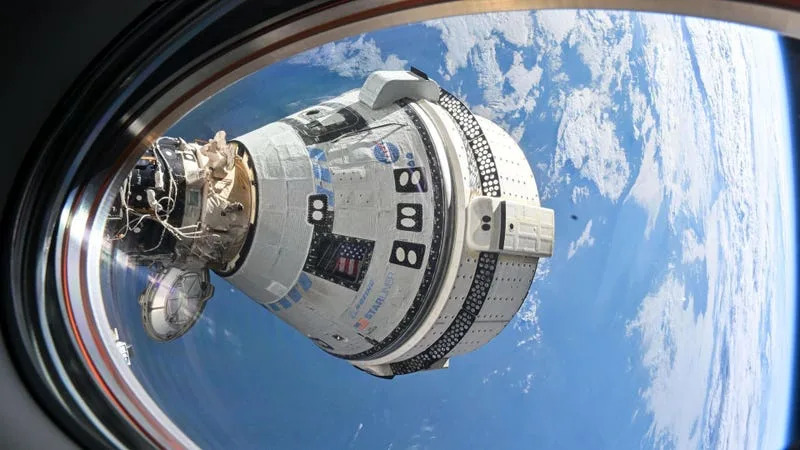
Photo: NASA
With NASA announcing that astronauts Butch Wilmore and Suni Williams will return to Earth next March on SpaceX’s Crew-9 mission, the focus quickly shifted to what will happen to the beleaguered Boeing Starliner. The space agency plans to autonomously undock the craft from the International Space Station but fears the Starliner could drift out of control and potentially crash into the station.
NASA outlined a plan to shove the Starliner as away from the ISS as quickly as possible without overstressing the thrusts that caused this dilemma in the first place. This breakout burn procedure will be a series of a dozen short and sharp thruster burns. In a teleconference on Wednesday, Johnson Space Center lead flight director Anthony Vareha explained:
“The reason we chose doing this breakout burn is simply it gets the vehicle away from Station faster and, without the crew on board, able to take manual control if needed. There’s just a lot less variables we need to account for when we do the breakout burn and allows us to get the vehicle on its trajectory home that much sooner.”
NASA vigorously attempted to find fixes while Wilmore and Williams ended up stranded on the ISS. The space agency confirmed during a briefing last month that engineers were able to recreate the thruster’s issues during tests at White Sands Test Facility in New Mexico, SpaceNews reported. The Teflon seal around a poppet, a thruster valve, expanded and started extruding out as the thruster headed up. The melted Teflon then constrained the propellant’s flow.
When the Starliner shoves off, it will open up space on the ISS for the Crew-9 Crew Dragon. Colonel Nick Hague will command the mission, becoming the first Space Force Guardian selected to go to space. However, the achievement comes with a caveat: he’s already been to space. Hague graduated from the U.S. Air Force Academy in 1998 and was selected to become an astronaut in 2013, but he transferred to the Space Force in 2021.
I want to believe that the Space Force is a real military branch and not just a scheme by Air Force Space Command to get more funding and promotions with ugly uniforms and forced traditions. At least the fledging service is more capable than Boeing.
a bright green streak can be seen above earth as seen from space
Hubble Telescope spies a very sparkly mini-galaxy (image)
Victoria Corless
Wed, September 4, 2024
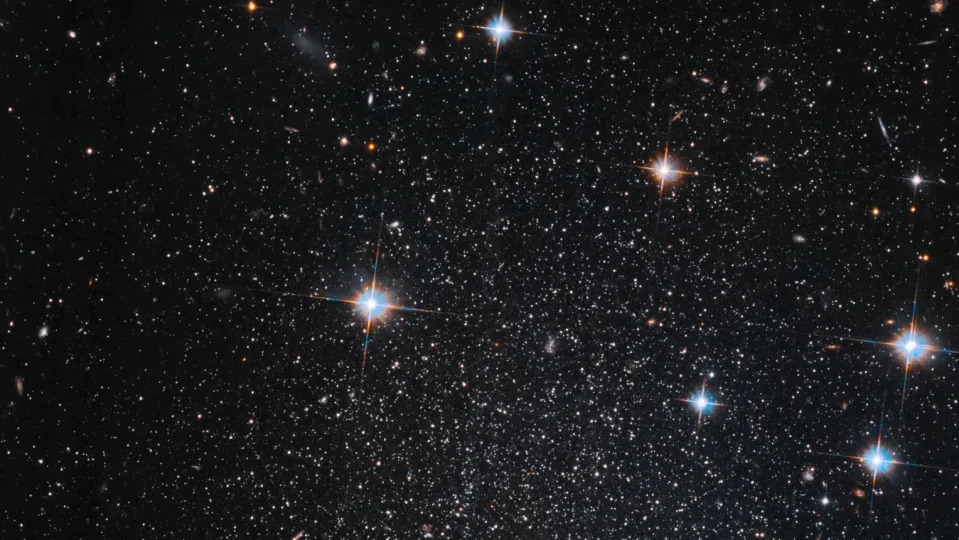
The Pegasus Dwarf spheroidal galaxy, also known as Andromeda VI, is one of at least 13 dwarf galaxies that orbit the Andromeda galaxy. | Credit: NASA, ESA, and D. Weisz; Processing: Gladys Kober
New images released by NASA's Hubble Space Telescope are of the Pegasus Dwarf spheroidal galaxy, also known as Andromeda VI.
Pegasus is located in the Andromeda Galaxy, also called Messier 31, which is the Milky Way’s closest neighbour at about 2,480,000 light-years away from Earth. As such, Andromeda is one of the few galaxies visible to the naked eye — best observed in November.
The images were captured as part of a re-examination of the entire Andromeda system, meant to gather further information to answer long-standing questions related to dark matter, reionization and the growth of galactic ecosystems across cosmic time, according to a NASA statement.
The Andromeda galaxy is host to at least 13 dwarf galaxies that orbit around it, one of which is the Pegasus Dwarf spheroidal galaxy. Pegasus was first identified in 1998 thanks to the sharp eyes of an amateur astronomer. It almost slipped notice due to the dim nature and relatively small sizes of dwarf spheroidal galaxies like this one.
Related: Hubble telescope captures stunning shot of spiral galaxy (photo)
Pegasus, and galaxies like it, contain very few "heavy" elements — elements heavier than helium, such as carbon, oxygen and iron — suggesting it hasn't experienced many cycles of star formation. In more evolved galaxies, the birth and death of stars results in a chemical enrichment, also known as a galaxy's chemical evolution.
However, these dwarf spheroidal galaxies — which are generally devoid of gas and experience very little new star formation — are instead populated by old and intermediate-age stars. It is possible that Andromeda's massive gravitational field may have stripped the star-forming gases from Pegasus, leaving only enough material for a few generations of stars.
"In comparison, some of the dwarf spheroidal companion galaxies of the Milky Way found at comparable distances do contain some intermediate-age stars, but this could be because Andromeda is so massive and extended that its gravitational effects extend farther," NASA scientists explain.
Pegasus is therefore likely a fossil of the first galaxies, making it a valuable subject for studying the ancient universe.
Jeffrey Kluger
Wed, September 4, 2024
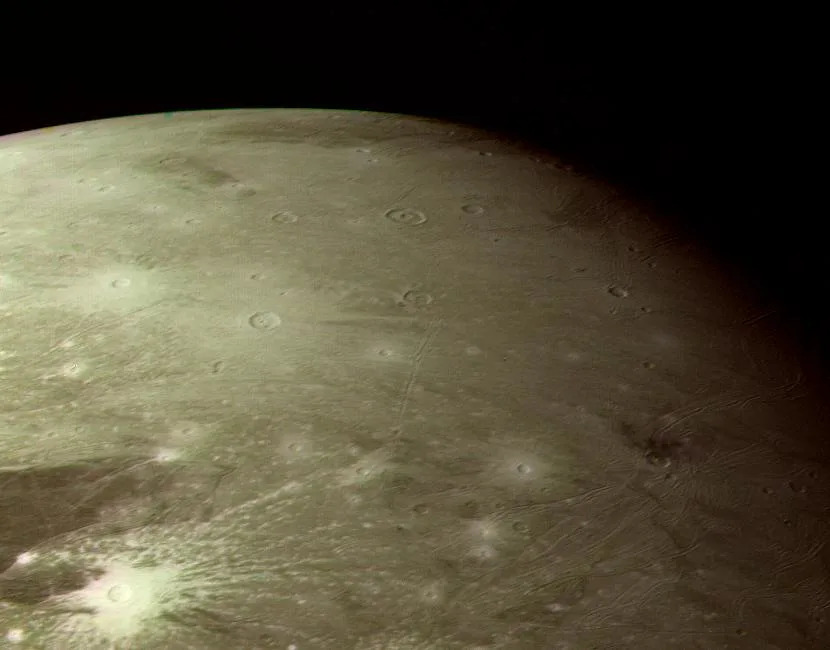
Bright Ray Craters in Ganymede's Northern Hemisphere
The asteroid collision that killed the dinosaurs 65 million years ago may have been a major cosmic crack-up, but it was nothing compared to a bigger impact that occurred roughly four billion years earlier, between an incoming rock and Jupiter’s moon Ganymede. That’s the conclusion of a new study in Scientific Reports, suggesting that the distant world was knocked completely sideways by the long-ago bombardment.
Ganymede is one of the most complex of Jupiter’s nearly 100 moons—and indeed, one of the most intriguing worlds in the entire solar system. It is the only known moon with its own magnetic field and is believed to have a salty ocean 60 miles deep, lying beneath a 95-mile thick crust. That makes it a prime place for the potential emergence of life. At nearly 3,300 miles in diameter, Ganymede is also the solar system’s largest moon—bigger even than the 3,030-mile wide planet Mercury. But that doesn’t mean it’s impervious to a pounding.
Like our moon, Ganymede is tidally locked—meaning it keeps the same face pointed to its parent planet at all times. In the 1980s, astronomers discovered a radiating system of ripple-like furrows exceeding 1,000 miles in diameter at the center of the moon’s far side. A scar like that could only have been formed by an impact—but just how cataclysmic it was had never been clear. The scale of the collision could have implications for the internal structure and temperature of the moon, which in turn could have implications for the emergence of life. Now, planetologist Hirata Naoyuki of Kobe University in Japan believes he knows more about the force of the impact—and the size of the impactor.
Read more: 2024 Marks an Important Year in NASA’s Search for Extraterrestrial Life
Naoyuki ran a computer model estimating that the incoming ordinance that left the ripples would have to have measured at least 185 miles across—absolutely massive compared to the dino-killing rock—especially considering the relative sizes of Ganymede and Earth. The asteroid that struck our planet measured no more than 10 miles across, or 0.112% of the size of the 7,917-mile diameter Earth. Ganymede’s asteroid was fully 5% of its diameter.
That kind of blow not only left a scar, it also knocked the world cockeyed. According to Naoyuki’s calculations, the far side of Ganymede, where the ripples are, was once located in the north polar region of the moon. But the force of the blow and the added weight of the asteroid tipped the moon on its side. As the New Horizons spacecraft discovered in 2015, a similar collision led to a similar tipping at Pluto, a dwarf planet that rotates effectively on its side, at a 57-degree angle relative to its revolution around the sun. That impact may have had a role in creating Pluto’s litter of five moons—Charon, Nix, Hydra, Kerberos, and Styx.
Ganymede will be studied more closely still in 2034, when the European Space Agency’s JUICE (Jupiter Icy Moons Explorer) spacecraft, launched in 2023, arrives at the moon and goes into orbit around it. Hirata is counting on that to extend astronomers’ knowledge of Ganymede and similar moons further.
“I want to understand the origin and evolution of Ganymede and other Jupiter moons,” he said in a statement that accompanied the release of his study. “I believe that further research applying [to] the internal evolution of ice moons could be carried out next.”
Write to Jeffrey Kluger at jeffrey.kluger@time.com
— Milky Way's cosmic neighbors help bring ancient galaxies into focus
— Hubble telescope reels in gorgeous, star-spawning cosmic jellyfish (photo)
— Can you see the cosmic 'cat' grinning into one of the world's largest telescopes in this photo? (video)
The mystery of vampire star rejuvenation solved
This finding is an important missing link in the rejuvenation of these stars.
A team of astronomers from the Indian Institute of Astrophysics (IIA), an autonomous institute of the Department of Science & Technology, Government of India, discovered a vampire star in M67. This discovery offers significant clues on a complex rejuvenation process known as mass transfer in a binary system.
Vampire stars, also called blue straggler stars (BSS), can easily be found in star clusters. They show several characteristics of younger stars and defy simple models of stellar evolution.
This unusual young star is thought to be rejuvenated by taking material from a nearby binary star. Star clusters are good places to study this because they have many binary stars, some of which form vampire stars.
These rejuvenated stars evolve differently from single stars like the Sun. However, finding the material they’ve absorbed and spotting their companion star has been challenging.
Star clusters are ideal laboratories for understanding the life and death of single and binary stars. M67, in the Cancer constellation, is one such interesting star cluster.
This newly discovered vampire star- called WOCS 9005- bears the chemical imprint of recently sucked barium-rich material from its binary companion and unambiguously detected emission from the dead-remnant of its companion.
The team discovered this using the UltraViolet Imaging Telescope data onboard AstroSat, India’s first dedicated space observatory. Using spectroscopy, they studied the vampire star’s surface composition.
The spectra of stars are bar codes that decipher their surface/atmosphere chemistry. The team used the archival spectral data from the GALAH survey (GALactic Archeology using Hermes), which used the Two-Degree Field fibre positioner with the HERMES spectrograph at the Anglo-Australian Telescope.
Harshit Pal, the paper’s lead author, said, “This star is expected to show chemistry very similar to our Sun, but we found that its atmosphere is rich in heavy elements such as barium, yttrium, and lanthanum.”
These heavy elements are rare and are mostly found in stars called asymptotic giant branch (AGB) stars. In these stars, a slow process called s-process uses neutrons to create heavy elements from lighter ones. This process makes about half of the atomic nuclei heavier than iron. Before AGB stars die and become white dwarfs, they shed their outer layers rich in these heavy elements. However, AGB stars are more massive and evolved than WOCS 9005, which is puzzling.
Prof. Annapurni Subramaniam, co-author of the paper and Director IIA, said, “The presence of heavy elements in the spectrum pointed to a polluted atmosphere of the vampire star and an external source of pollution. The external source is likely to be its binary companion, which must have made the heavy elements when it passed through its AGB phase and later became a white dwarf star.”
“The blue straggler star that we see now must have eaten up most of this barium-rich material due to its gravitational pull and is now presenting itself as a rejuvenated star. When the enhancement of barium (and other s-process elements) is detected in stars earlier than the AGB evolutionary phase, such as the main sequence (MS), subgiant (SG), or red giant branch (RGB), these stars are called barium stars.”
Dr. Bala Sudhakara Reddy, a co-author of the paper, said, “The presence of significant barium in this vampire star makes it the first barium blue straggler star discovered in the cluster M67. The mass transfer from a companion AGB star has been extensively studied, though only a few chemically enriched post-mass transfer binaries have been identified in star clusters. Having established that the mass transfer took place, the team started their search for the unseen companion.”
The vampire star was known to have a tiny, unseen companion that is half the mass of the Sun. Scientists used the Ultra-Violet Imaging Telescope (UVIT) on the AstroSat satellite to take pictures of the vampire star and measure its UV brightness.
As its temperature is similar to the Sun’s, it was unexpectedly bright in the UV. Scientists detected considerable UV brightness for this star, which, on analysis, proved that it indeed originated from its hot and small companion.
Based on theoretical calculations and validations, scientists confirmed that this is indeed the remnant of the star that produced heavy elements and that the two stars are close enough to transfer the matter from the donor star through the wind.
“This is for the first time the white dwarf remnant of the donor is sighted in the case of the polluted blue straggler star, said Pal. This discovery experimentally confirms the theoretical prediction that vampire stars are formed by acquiring polluted matter through transfer from their companion, leaving behind a remnant white dwarf. The rarity of such chemically polluted systems is still a mystery, and the team thinks that it may be due to the quick settling of the pollutants in the atmosphere of the vampire stars.”
Journal Reference:
- Harshit Pal, Annapurni Subramaniam, Arumalla B. S. Reddy and Vikrant Jadhav. Discovery of a Barium Blue Straggler Star in M67 and “Sighting” of Its White Dwarf Companion. The Astrophysical Journal Letters. DOI 10.3847/2041-8213/ad6316

